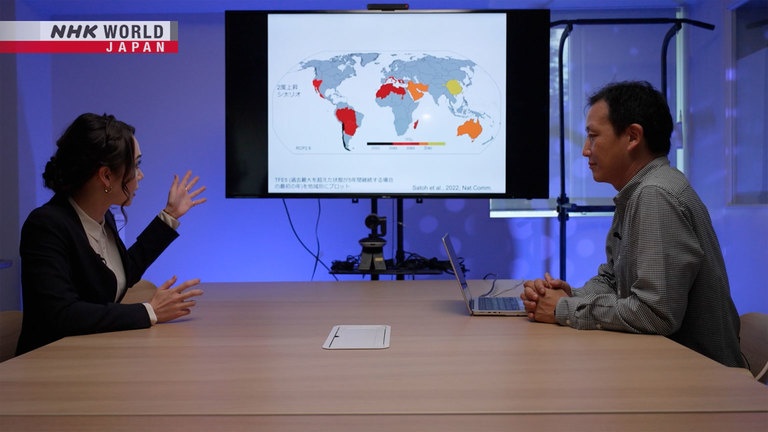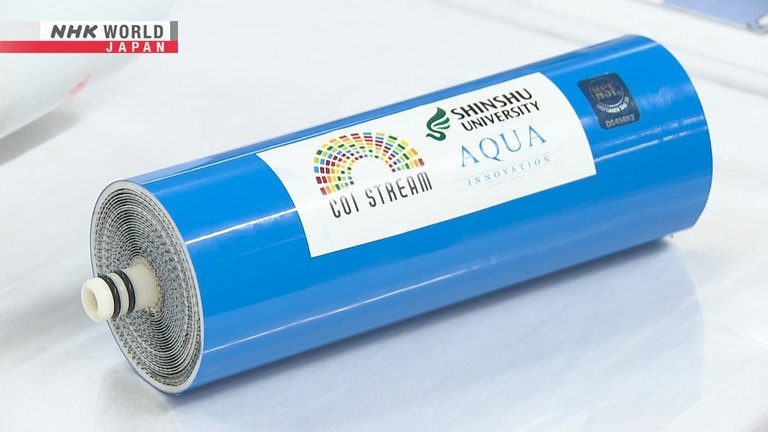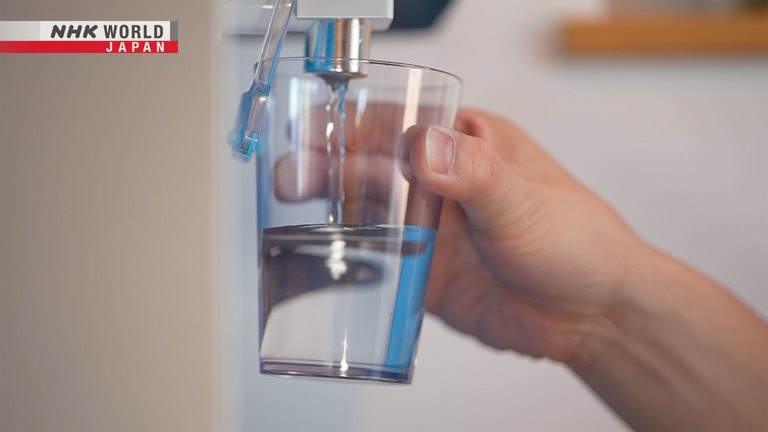#35 Droughts
Droughts are increasing due to global warming. The latest simulations predict that megadroughts could occur along the Mediterranean coast and the west coast of the US. Now, Japan's cutting-edge technology is attracting attention as a solution to water scarcity. In Saudi Arabia, there are high hopes for using a filter developed by Shinshu University that removes over 99% of salt content from seawater. Meanwhile, Egypt is looking into a water dispenser developed by a Japanese venture company which produces drinking water from air.




Transcript
Japan has a long history of natural disasters.
Now, the power of science has helped it to overcome them.
BOSAI: Science that Can Save Your Life.
This arid desert landscape... was once covered with lush greenery, filled with life.
What robbed the land of its greenery was drought.
A drought is a state where a region experiences an extended period of very little rain.
A drought not only kills crops and cause famine, but it can also lead to forest fires.
And now... it is becoming clear that we face a level of threat that we've never experienced before.
There is a threat of a severe drought
called a "megadrought."
In the near future, we can expect to see severe droughts occurring frequently in the US, Europe, and Asia.
Today, we will find out what happens during a megadrought.
And, we'll also look at Japan's new technology that could save the world from drought.
We visited Professor Kei Yoshimura at the University of Tokyo,
who uses supercomputers and other technologies to predict global weather phenomena.
I often see news about droughts lately.
Droughts are said to be more widespread
and more frequent worldwide.
Do you remember last year?
Europe experienced a severe drought,
said to occur once every 500 years.
In 2022, Europe was hit with intense heat.
It is estimated that at least 15,000 people lost their lives due to the heatwave and related factors.
In China, an extreme drought in the Yangtze River basin triggered severe water and food shortages.
Global warming is thought to be the major cause of these droughts.
Global temperatures have risen by an average of 1.1 degrees Celsius
since before the Industrial Revolution in the 18th century.
Now, it is said that we have entered the era of global boiling.
Will droughts get worse in the future?
Yes, we believe so.
We can expect to see more droughts
at a scale we've never experienced before.
And that's likely to become the new norm.
For example, we may see a 50% drop in precipitation during summer, or experience a month or more of no rain...
Or rivers may dry up for the first time ever.
It is thought that large-scale droughts that the region has never experienced before,
will occur more frequently in many parts of the world.
We're alarmed by what are called
"megadrought."
What will happen to the world during the period of megadroughts?
The results of the study Yoshimura and his team published in 2022 sent shockwaves throughout the world.
Is this the prediction of your research?
Yes, it shows the areas megadroughts
are likely to occur in the future.
This is a simulation based on an international study conducted jointly by 13 research institutes around the world.
It projects a scenario in which the global average temperature at the end of the 21st century
is approximately 2 degrees Celsius above the pre-industrial level.
The darker the color, the sooner a megadrought is predicted to occur.
For instance, the area around Chile in South America,
indicated in black, is believed that a megadrought has already begun.
Meanwhile, countries along the Mediterranean Sea are predicted to experience megadroughts starting around 2040.
The phenomenon is also projected for Australia and China after 2070.
There seems to be some pattern.
Is there any reason for this?
Yes. The tendency is to occur in areas
30 degrees north and south of the equator.
There are characteristics to places where megadroughts are likely to occur.
Areas near the equator receive more sunlight and thus are warmer.
But they also get more rainfall so they are relatively less prone to drought.
On the other hand, the regions 30 degrees north and south of the equator,
or the so-called arid region, receive little rainfall and are exposed to strong sunlight.
Droughts are predicted to become more extensive, especially in these regions.
If droughts get this bad,
there must be negative impacts.
The worst impact that comes to mind
is food production.
Grain-producing regions depend on
large-scale irrigation.
The lack or water supply
could hamper food production.
Areas where drought is becoming more severe are also grain-producing regions that yield much harvest.
The combination of abundant Sunshine and moderate dryness helps grow wheat,
corn and other crops, contributing to the world's food supply.
Many people live in this region because they can use water to produce food.
Water is indispensable for food production.
Professor Yoshimura led me to the university cafeteria to help me get a true understanding of this.
Lemi, how much water is used
to make this curry?
How much water?
It depends on the serving,
but maybe 1 liter?
For cooking curry, that's about right.
But there's virtual water which represents
how much water is used
to make the ingredients of curry
such as rice, beef, and roux.
Virtual water?
Virtual water is the amount of water used for producing food.
For example, it takes 12,000 tons of water to raise 1 cow.
This beef curry contains approximately 70 grams of beef.
It also has other ingredients such as onions and carrots.
If you add all of the water used for these ingredients, how many liters of water would be needed?
It takes 1,947 liters of water
to make one serving of curry.
That's a lot of water.
Yes, 2 tons.
Making beef curry requires 1,947 liters, and for a Salisbury steak set, it takes 2,296 liters of water.
There is so much hidden water in our food.
The world is faced with the threat of droughts.
Now, a promising technology in Japan could play an important role.
July 2023.
Shinshu University and Saudi Arabia's Saline Water Conversion Corporation (SWCC) have agreed to begin joint research.
This is a part of an equipment developed by Shinshu University.
This special filter removes more than 99% of the salt content from seawater.
This is an effort to solve water shortage by converting the seawater into fresh water to be used for agriculture and daily life.
One of the most precious water resources is... drinking water.
Because it is directly consumed by people, it's essential that it is clean.
In Japan, a new technology has been developed to produce drinking water from a certain resource.
We came to a park in Tokyo.
The water dispenser in the resting area holds the key to solving the problem of water shortages.
This looks like a typical water dispenser.
I'm going to get some water to drink because it's important to stay hydrated.
Mmm. Delicious.
So what makes this water dispenser so special?
We asked Tachiyama Yoshito from the company that developed the dispenser.
How does the water dispenser work?
Water is made by capturing air
into the machine and cooling it rapidly.
You make water from air?
That's not your typical water dispenser.
This is how it works.
Air is taken into the machine and is rapidly cooled, causing condensation.
This is how water is extracted.
However, as the water contains bacteria and other substances from the air,
it is sterilized using a unique device made up of silver ions and a filter.
Drinking water is produced over a period of about 5 hours.
Why did you decide to make water from air?
Water scarcity is a major global issue.
Not everyone lives near a river or lake.
So how can people living far from
water sources obtain water?
It took us about 10 years
to develop a machine that makes
safe drinking water from air.
Yum!
Currently, this new dispenser is being used in many places,
such as evacuation centers, schools, factories and homes.
Tachiyama is planning to further expand the use of the water dispenser.
It's been proven to produce enough
drinking water even in dry regions.
This technology has a solid track record.
By dry regions, do you mean deserts?
Yes. We were able to produce water
in an Egyptian desert.
That's amazing!
Egypt has a very dry climate.
In addition, the population is growing rapidly,
and there are concerns about facing severe water shortages.
Furthermore, the country is 95% dependent on the Nile River for its water resources.
Once a megadrought occurs, the impact would be devastating.
To take measures, the Egyptian government decided to adopt Tachiyama's water dispenser.
However, there was the challenge of electricity.
The process of producing water requires more electricity than an ordinary water dispenser.
Tachiyama and his team focused their attention on renewable energy such as solar power,
taking advantage of the strong sunlight.
We're working on powering the dispenser
by using sustainable
environmentally friendly energy.
This year, we experienced the hottest summer ever in Japan.
And most likely, people around the world are feeling the same thing... that the climate is indeed changing.
Water is essential for our survival.
In this period of megadrought, Japan's technology could be the solution to the world's water shortages.